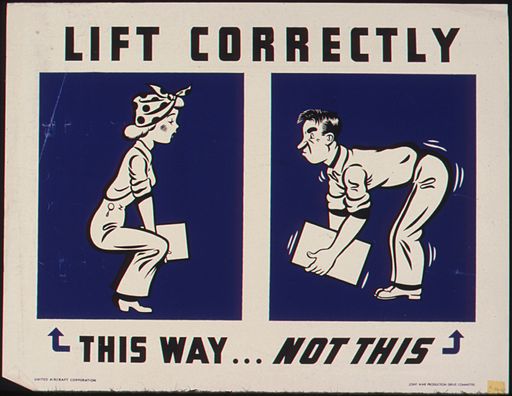Moving Boxes ‑ Safe Work Practices
Employees who lift boxes must exercise caution and use proper lifting techniques to reduce the risks of injury, especially to their back, arms, wrists and feet. Employees should also take precautions against dust exposure when necessary.
To reduce the risk of injury when moving boxes:
- Employees should wear long-sleeved shirts, long trousers, shoes that cover the complete foot, and protective gloves
- Face masks should be used if required
- Employees should be made aware of and practise proper lifting techniques and never attempt to lift or carry a box heavier than they are capable of moving with ease
- Boxes must be assembled properly and have a secure, fitted lid
- Boxes should weigh no more than 35 pounds (15.5 kg)
- Boxes should never by stacked more than five high (all employees should be able to look down at the lid of the highest box)
- Boxes should be lifted by their handles and not carried from underneath
- Boxes should be moved with the aid of a cart or other equipment between floors or over any distance
Proper Lifting Techniques
Most back problems occur over a period of time. Careful attention to lifting on the job and at home and regular exercise to maintain fitness and strength will help you maintain a healthy back. The following principles will assist in lowering your risk of back pain due to lifting.
- Size up the load. Test it to see if you can lift it safely. Can you grasp it securely? Good handholds (cut-outs, handles) will make the load easier to lift. Make sure the load is balanced in your hands.
- Get as close to the load as possible before lifting it. If possible, slide the load towards you before picking it up.
- Make sure your footing is secure. Do not lift objects that obscure vision and footing.
- Do not twist while lifting! Move your feet so that they point in the direction of the lift as you turn.
- Lift smoothly, but not slowly. Do not jerk the load.
- Organize the work so as to avoid lifting from the floor or above shoulder level. Items to be handled should be between knee and shoulder height.
- Keep the load as close to your body as possible. If the load is large and cannot be placed between your knees as they are bent, bend at the hips and waist with your knees relaxed. It is more important to keep the load close than it is to bend your knees. One solution to lifting a larger load is to get another person to help you. A better solution is to use mechanical assistance (hand trucks, carts) to avoid lifting altogether. GET HELP WITH LARGE LOADS
- If you have a lot of lifting to do during the day, try not to do it all at once. Alternate lifting tasks with lighter work to give your body a chance to recover. Remember, mechanical assistance is just as important for repetitive lifting as it is for heavy lifting.
- Use the same principles when lowering or placing the load after lifting. Place carefully.
- Try to avoid carrying the load more than 10 feet without getting mechanical assistance. Use a dolly or cart.

